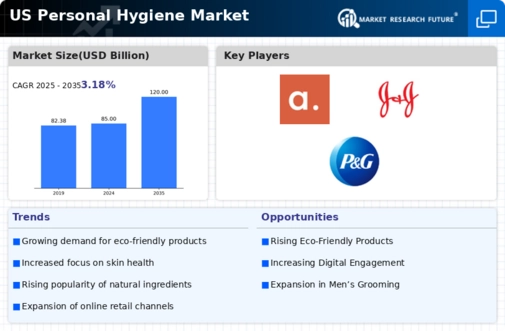The personal hygiene market exhibits a dynamic competitive landscape characterized by rapid innovation and evolving consumer preferences. Key players such as Procter & Gamble (US), Unilever (GB), and Johnson & Johnson (US) are at the forefront, leveraging their extensive product portfolios and brand equity to capture market share. Procter & Gamble (US) emphasizes sustainability in its product development, aiming to reduce plastic waste by 50% by 2030, which aligns with growing consumer demand for eco-friendly products. Unilever (GB) focuses on digital transformation, enhancing its e-commerce capabilities to reach a broader audience, while Johnson & Johnson (US) invests heavily in research and development to introduce innovative personal care solutions that cater to diverse consumer needs. Collectively, these strategies foster a competitive environment that prioritizes sustainability, digital engagement, and product innovation.
In terms of business tactics, companies are increasingly localizing manufacturing to enhance supply chain efficiency and reduce costs. This approach not only mitigates risks associated with The personal hygiene market demands. The competitive structure of the market appears moderately fragmented, with several key players holding substantial market shares, yet numerous smaller brands also contribute to the diversity of offerings available to consumers. This fragmentation encourages innovation and competition, as established companies strive to differentiate themselves from emerging brands.
In October 2025, Unilever (GB) announced a partnership with a leading tech firm to develop AI-driven personal care products tailored to individual skin types. This strategic move is likely to enhance Unilever's product personalization capabilities, thereby increasing customer satisfaction and loyalty. By integrating advanced technology into its product development, Unilever positions itself as a pioneer in the market, potentially setting new standards for customization in personal hygiene.
In September 2025, Procter & Gamble (US) launched a new line of biodegradable personal care products, reinforcing its commitment to sustainability. This initiative not only addresses environmental concerns but also aligns with consumer trends favoring eco-conscious brands. The introduction of biodegradable options may attract a segment of the market that prioritizes environmental impact, thereby expanding Procter & Gamble's customer base and enhancing its competitive edge.
In August 2025, Johnson & Johnson (US) unveiled a comprehensive digital marketing campaign aimed at promoting its latest personal hygiene innovations. This campaign leverages social media platforms to engage younger consumers, who are increasingly influential in shaping market trends. By adopting a digital-first approach, Johnson & Johnson seeks to enhance brand visibility and foster deeper connections with its target audience, which could lead to increased market penetration.
As of November 2025, the personal hygiene market is witnessing trends that emphasize digitalization, sustainability, and the integration of AI technologies. Strategic alliances among key players are shaping the competitive landscape, enabling companies to pool resources and expertise to drive innovation. The shift from price-based competition to a focus on technological advancement and supply chain reliability is evident, suggesting that future competitive differentiation will hinge on the ability to innovate and respond to consumer demands effectively.














Leave a Comment